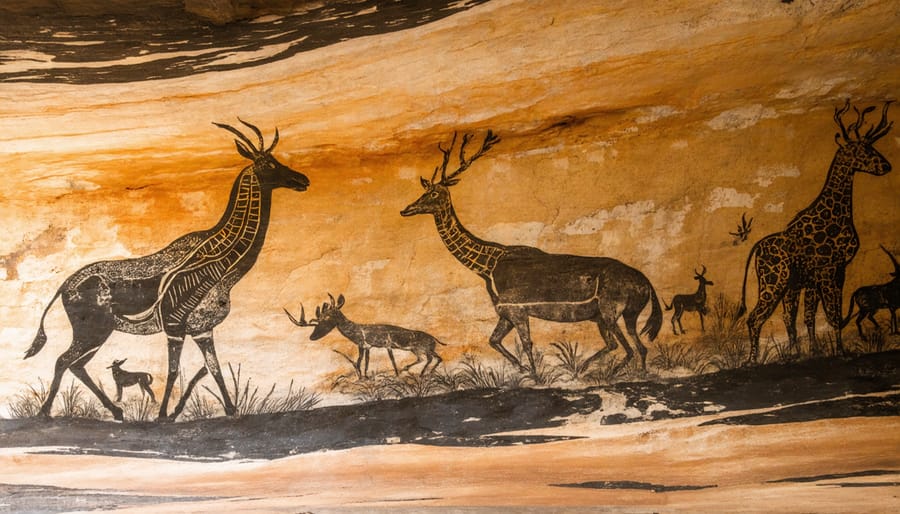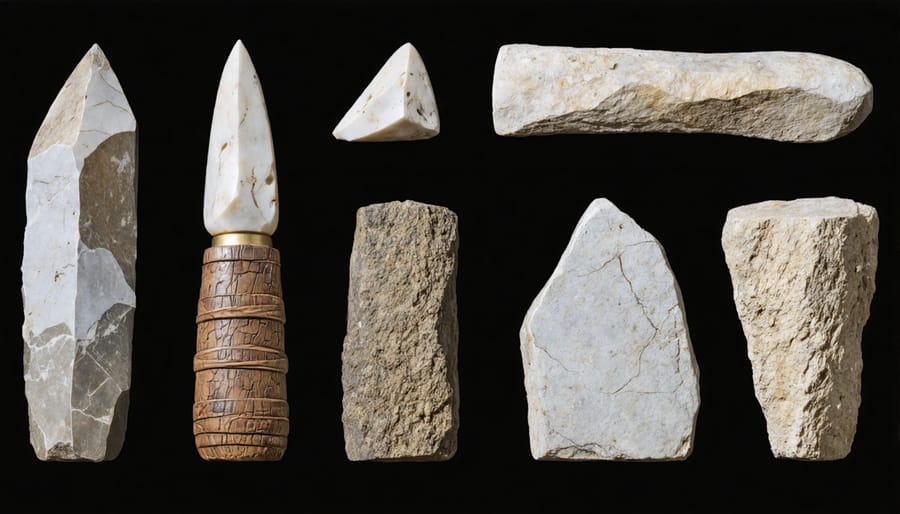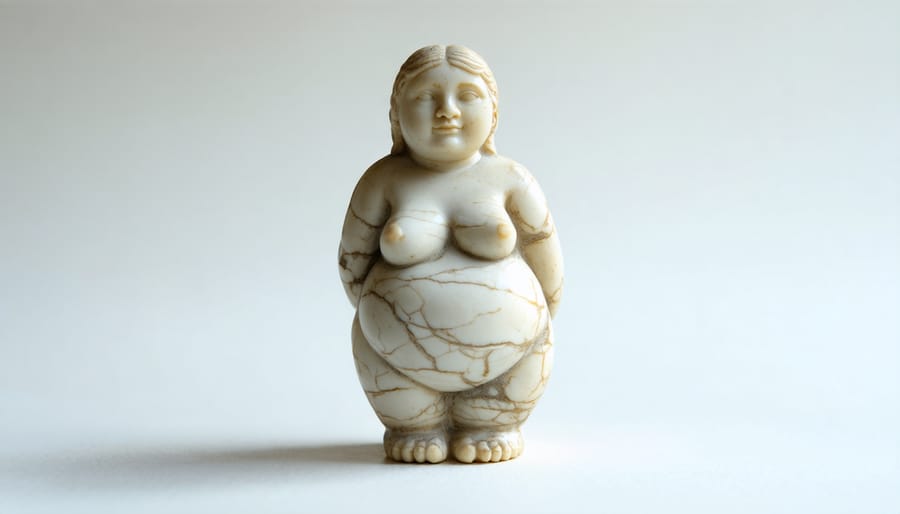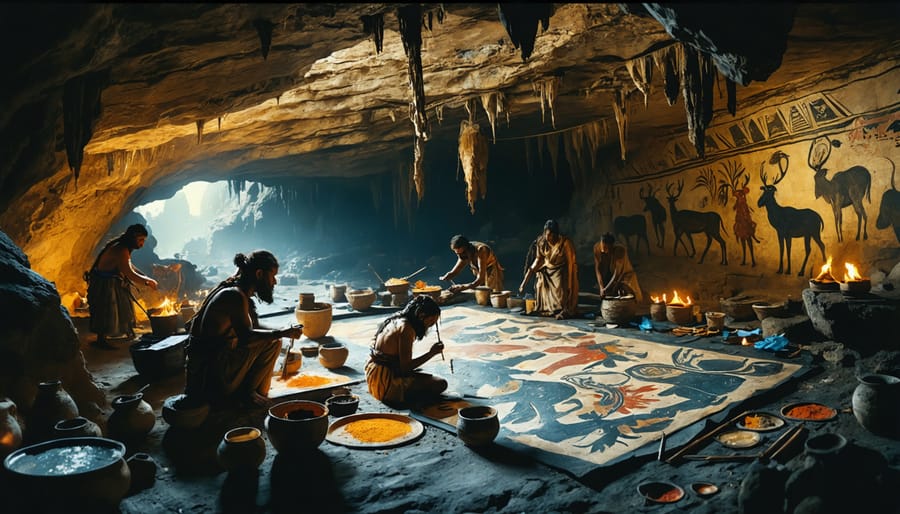Deep within the caves of our ancient past lies a remarkable testament to human creativity – Stone Age art stands as our earliest window into human consciousness and artistic expression. From the breathtaking cave paintings of Lascaux to delicately carved Venus figurines, these prehistoric masterpieces mark the beginning of humanity’s journey of stone through history.
Created between 40,000 and 10,000 BCE, Stone Age art encompasses far more than simple primitive markings. These sophisticated works demonstrate our ancestors’ remarkable ability to observe, interpret, and represent their world through various mediums – from ochre-painted walls to intricately carved bone and stone implements. Their artistic achievements laid the foundation for all subsequent human creative expression, establishing techniques and symbolic systems that continue to influence artists today.
What makes these prehistoric artworks particularly fascinating is not just their age, but their extraordinary technical sophistication and emotional depth. These pieces reveal complex spiritual beliefs, social structures, and a deep understanding of the natural world – challenging our modern assumptions about prehistoric human capabilities and consciousness.
The Dawn of Artistic Expression
Cave Paintings and Rock Art
Cave paintings represent humanity’s earliest natural stone masterpieces, dating back 40,000 years. These ancient artworks, preserved on limestone and granite cave walls, offer remarkable insights into prehistoric life and artistic expression. The most famous examples, found in locations like Lascaux, France, and Altamira, Spain, showcase sophisticated techniques using natural pigments derived from minerals, charcoal, and ochre.
The durability of stone surfaces played a crucial role in preserving these artworks through millennia. Cave walls provided ideal canvases, protecting the paintings from weathering and environmental degradation. Artists deliberately chose areas with specific mineral compositions and surface textures, demonstrating an early understanding of stone’s properties as an artistic medium.
The paintings typically depict wildlife, hunting scenes, and human hands, created using techniques such as finger tracing, brush application, and pigment blowing through hollow bones. These methods established foundations for stone art that would influence countless generations of artists and craftsmen, marking humanity’s first steps in manipulating stone for artistic expression.

Early Stone Sculpture
The earliest known stone sculptures date back approximately 230,000 years ago, marking humanity’s first attempts at artistic expression in durable materials. These primitive works primarily consisted of naturally shaped stones that were modified through basic carving techniques, creating simple but recognizable forms.
Notable examples include the Venus of Berekhat Ram, discovered in the Golan Heights, and the Venus of Tan-Tan from Morocco. These figures, though crude by modern standards, demonstrate early humans’ ability to recognize and enhance natural stone forms to represent the human figure.
As tools and techniques evolved, stone carving became more sophisticated. By 30,000 BCE, artists were creating more detailed figurines, particularly focused on female forms known as Venus figurines. The most famous of these, the Venus of Willendorf, showcases remarkable craftsmanship despite being created with simple stone tools.
Relief carvings also emerged during this period, with notable examples found in European cave sites. These works often depicted animals and hunting scenes, carved into cave walls and rock faces using stone tools and repeated striking techniques. The precision and detail achieved in these early works laid the foundation for all subsequent stone sculpture traditions.
Stone Working Techniques in Prehistoric Times
Tools and Materials
Stone Age artists worked with a surprisingly diverse array of tools and materials to create their masterpieces. The most common implements included hammerstones, bone tools, and sharp flint implements for carving and etching. These basic tools were often crafted from locally available materials, with particular preference given to hard, durable stones like flint, obsidian, and quartzite.
For painting, our ancestors developed sophisticated pigments from natural materials. Red ochre, derived from iron oxide, was particularly favored and has been found at numerous prehistoric sites worldwide. Yellow ochre, charcoal, and white calcium-based pigments were also commonly used. These colors were ground into fine powder and mixed with various binders such as animal fat, water, or blood to create durable paints.
The selection of stone surfaces for artwork was equally deliberate. Cave walls with smooth limestone surfaces were preferred for paintings, while harder stones like granite and basalt were chosen for carved artifacts. Tools for fine detail work included bird bones fashioned into primitive brushes, hollow reeds for blown pigment application, and carved antler tools for precise engraving.
These early artists also demonstrated remarkable ingenuity in creating lighting solutions, using animal fat lamps and torches to illuminate their cave workspaces, enabling them to create complex compositions deep within cave systems.

Carving Methods
Stone Age artists employed various sophisticated carving techniques to create their enduring masterpieces. The most common method involved percussion flaking, where artisans struck stones against each other to chip away unwanted material. This technique required precise control and understanding of how different stone types behaved under impact.
Pressure flaking represented a more refined approach, using bone or antler tools to apply controlled pressure along stone edges, creating detailed patterns and shapes. This method allowed for greater precision and was particularly useful for creating intricate designs and figures.
Abrading and grinding techniques were also fundamental to Stone Age carving. Artists would rub stones against harder surfaces or use sand as an abrasive medium to smooth surfaces and create specific textures. This process could take many hours or even days to achieve the desired result.
For deeper relief work, Stone Age craftspeople developed pecking techniques, repeatedly striking the stone surface with pointed tools to gradually wear away material. This method was particularly effective for creating three-dimensional figures and detailed cave art.
Tool marks found on surviving artifacts reveal that artists often combined these techniques, switching between methods as needed to achieve their artistic vision. They demonstrated remarkable understanding of stone properties, selecting specific tools and techniques based on the hardness and grain of their chosen material.
Notable Stone Age Art Sites

European Sites
Europe houses some of the most significant Stone Age art sites, offering invaluable insights into early human creativity and cultural development. The Lascaux Cave in southwestern France stands as one of the most remarkable examples, featuring over 2,000 figures painted approximately 17,000 years ago. Its walls showcase vibrant depictions of animals, including aurochs, horses, and deer, executed with sophisticated painting techniques and natural pigments.
The Altamira Cave in northern Spain represents another masterpiece of Paleolithic art, dating back roughly 35,000 years. Its ceiling, often called the “Sistine Chapel of Prehistoric Art,” displays polychrome bison paintings that demonstrate remarkable artistic sophistication and understanding of natural rock contours.
Chauvet Cave in southern France, discovered in 1994, contains the oldest known cave paintings, created around 32,000 years ago. The site features exceptionally well-preserved artworks, including detailed rhinoceros, lions, and bears, showcasing advanced shading techniques and perspective.
Lesser-known but equally significant sites include the Côa Valley in Portugal, which contains thousands of open-air rock engravings, and the La Pasiega Cave in Spain, featuring abstract symbols alongside animal figures. These sites collectively demonstrate the widespread nature of Stone Age artistic expression across Europe.
The preservation of these sites presents ongoing challenges, with many now closed to the public to prevent deterioration. However, several locations offer detailed replicas and virtual reality experiences, allowing visitors to experience these ancient masterpieces while protecting the originals for future generations.
Global Discoveries
Stone Age art discoveries span across continents, offering invaluable insights into our ancestors’ creative expressions and cultural practices. The Lascaux Cave in southwestern France stands as one of the most remarkable repositories of Paleolithic art, featuring over 2,000 figures painted approximately 17,000 years ago. Its vibrant depictions of animals, abstract symbols, and human figures showcase sophisticated artistic techniques that challenge our perceptions of prehistoric capabilities.
Similarly, the Altamira Cave in Spain reveals masterful polychrome paintings dating back 35,000 years. These artworks demonstrate an advanced understanding of natural pigments and the strategic use of rock surfaces to create three-dimensional effects. Like other ancient stone monuments, these sites reflect humanity’s enduring connection to stone as an artistic medium.
In Africa, the Apollo 11 Cave in Namibia houses some of the oldest known artwork, with painted stones dating back 27,000 years. Australia’s Arnhem Land showcases extensive rock art galleries, with some pieces estimated to be 65,000 years old, representing the world’s oldest continuous artistic tradition.
Indonesia’s Sulawesi caves recently revealed 45,500-year-old cave paintings, challenging the Eurocentric view of artistic development. These discoveries suggest that sophisticated artistic expression emerged independently across different regions, utilizing similar techniques in working with stone surfaces and natural pigments.
Each site offers unique insights into early human creativity and technical innovation, demonstrating how our ancestors transformed natural stone surfaces into lasting cultural legacies that continue to influence modern stone artistry.
Legacy and Influence
Modern Stone Art Connections
Contemporary artists and architects continue to draw inspiration from Stone Age art, demonstrating the enduring impact of natural stone on human creativity. Modern stone sculptors often employ techniques remarkably similar to those used by their prehistoric counterparts, particularly in the initial stages of rough-cutting and basic shaping. The raw, organic qualities found in paleolithic cave paintings and petroglyphs have influenced numerous contemporary artists, who incorporate these primitive aesthetics into their work while using modern tools and technologies.
Notable examples include British sculptor Andy Goldsworthy, whose nature-based installations echo the site-specific approach of ancient rock art, and Eduardo Chillida, whose monumental stone works draw upon the primal relationship between humans and stone. In architecture, firms like Peter Zumthor’s have created modern structures that celebrate stone’s natural qualities in ways that would be familiar to our Stone Age ancestors.
The influence extends beyond fine art into practical applications, with contemporary stonemasons and craftspeople continuing traditions that date back millennia. Modern digital fabrication techniques are often combined with ancient hand-finishing methods, creating a bridge between prehistoric craftsmanship and contemporary innovation. This fusion of old and new demonstrates how Stone Age artistic principles remain relevant in today’s design landscape.
Preservation Techniques
The preservation of Stone Age art has been a remarkable testament to both natural durability and human ingenuity. Cave environments played a crucial role in protecting ancient artwork, with their stable temperatures and humidity levels creating ideal conservation conditions. Many cave paintings have survived for over 30,000 years due to these natural preservation factors.
Ancient artists also employed various techniques to ensure their work’s longevity. They often selected naturally sheltered locations and used mineral-based pigments that bonded chemically with rock surfaces. Red ochre, one of the most common pigments, contains iron oxide that forms a lasting bond with stone surfaces, contributing to the artwork’s preservation.
Modern conservation efforts focus on maintaining these delicate environmental conditions. Specialists monitor cave atmospheres, control visitor access, and use non-invasive documentation methods to study and preserve these irreplaceable artworks. Advanced imaging technologies help document and track changes in the artwork without physical contact.
Protective measures now include climate control systems, careful lighting management, and barriers to prevent direct contact with the art. Some sites, like Lascaux Cave in France, have even created exact replicas for public viewing to protect the originals from deterioration caused by human presence.
The success of these preservation techniques continues to provide invaluable insights into our ancestors’ artistic capabilities and cultural development, while informing modern conservation practices for stone-based art.
Stone Age art represents humanity’s first steps into creative expression, laying the foundation for all subsequent artistic developments. These ancient artworks, from the intricate cave paintings of Lascaux to the sophisticated Venus figurines, demonstrate that our ancestors possessed remarkable artistic capabilities and a deep understanding of working with stone materials.
The techniques developed during this era continue to influence modern stone artistry. The careful selection of stone surfaces, the manipulation of natural pigments, and the understanding of how different stones respond to various tools are principles that remain relevant in contemporary stone working. Many of today’s architectural and sculptural practices can trace their roots to these prehistoric innovations.
Perhaps most significantly, Stone Age art reminds us of stone’s enduring role as a medium for human expression. The survival of these ancient artworks, some dating back over 40,000 years, testifies to stone’s durability as an artistic medium. This legacy continues to inspire contemporary artists and craftspeople who work with natural stone, influencing everything from modern sculpture to architectural decoration.
The artistic achievements of our Stone Age ancestors demonstrate that creativity and technical skill in stone working have been fundamental to human culture since its earliest days. Their work not only provides invaluable insights into early human society but continues to inform and inspire our approach to stone artistry in the modern era.










